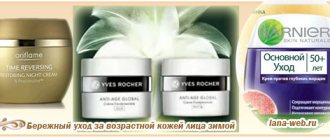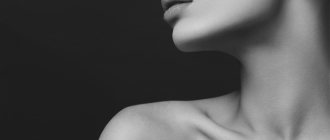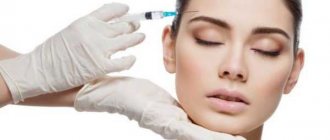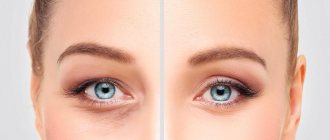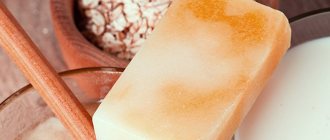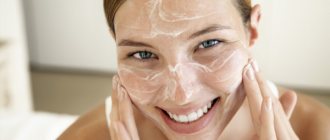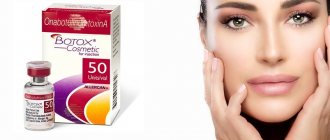Special skin care after biorevitalization is as important a step on the path to transformation as the procedure itself. The reason is that the main active ingredient, hyaluronic acid, is injected under the skin, which violates the integrity of the dermis.
Small hematomas, slight swelling, changes in skin color (pallor or redness), and soreness may appear at the puncture sites. Their intensity depends on how the preparation measures for the cosmetic procedure were followed.
What should not be done before biorevitalization?
Biorevitalization does not require special preparation. It is enough to visit a cosmetologist before the first course so that during a conversation you can find out all the details of the procedure, determine the tasks of the upcoming correction, and also find out how to care for your face afterwards.
The doctor must warn that if the client’s viral, skin, or allergic diseases worsen at the time of biorevitalization, it will have to be postponed. Beauty injections for visible and minor damage to the dermis are also prohibited.
A few days before biorevitalization you should not take the following medications:
- Changing blood clotting.
- Increasing capillary fragility
- Dietary supplements containing ginseng, ginko biloba.
Many cosmetologists warn clients that on the eve of the procedure they should not take alcohol, energy drinks and tonic drinks - tea and coffee in excessive quantities.
And if a solarium and sun rays the day before are also prohibited, as they dry out and thin the skin, a preliminary course of peelings is only welcome - this will help the filler to be absorbed better and more effectively.
Knowing how to properly perform biorevitalization on the face, the client will calmly respond to all manipulations without exposing the body to unnecessary emotional stress.
If you are a fan of cosmetic procedures, then you will be interested to know everything about care after facial cleansing.
It will also be useful for you to know how many days the papules last after biorevitalization.
If you want to rejuvenate your skin in simple ways, then read reviews and ratings about face creams after 40 years here.
Consequences of Beauty Injections (bruises, spots, swelling...)
Typical deviations after a treatment session:
- vascular embolism;
- tissue necrosis;
- white spots at injection sites;
- keloid scars;
- fibrosis;
- papules;
- bruises;
- swelling;
- granulomas;
- lack of sensitivity in the treatment area.
Compliance with the rules of the rehabilitation period is necessary not only to maintain the effect of the procedure. They will help prevent complications. After all, biorevitalization is done using injections into the thickness of the skin. That is, she receives microtraumas. During the procedure, biologically active substances are used, the reaction to which is not only positive.
| Possible skin reactions after biorevitalization | Why might they appear on the skin? |
| Bruises on the face | The skin contains many small blood vessels. They also exist in deeper layers. And if a specialist damages one of the vessels with a needle during the procedure, blood seeps out. This leads to the appearance of hematomas. In this case, care after the procedure should be aimed at accelerating their resorption |
| Change in skin color | It may turn red or become covered with white spots. This is a reaction to punctures and to the drug. Still, the process is an invasion of the functions of the skin, although aimed for good. Most often the reaction goes away after half an hour. But a longer presence is possible. If the redness does not subside for more than 2 days and is accompanied by a rash, there is reason to suspect an allergy |
| Tissue swelling | The accumulation of fluid is characteristic of the healing process of damaged skin at the very beginning. For some, it manifests itself mildly and goes away quickly. Others have to make efforts to make the complication disappear as quickly as possible. Facial swelling after biorevitalization may be a sign of an allergic reaction |
| Papules | The complication manifests itself in the form of swollen marks at the puncture points. Papules can remain on the face for 3 - 4 days, then they disappear. If they bother you for longer, you should seek help from a specialist. |
READ MORE: Why do you feel dizzy while dieting?
In addition to the common problems listed, an individual reaction to biorevitalization is also possible. These are, for example, dry skin, itching, pain. In each such case, proper care alone will not be enough; consultation with a specialist is necessary. Moreover, you will need to contact him if you find:
- changes in tissue sensitivity;
- lumps on the face;
- translucency of the drug through the skin in the form of stripes;
- nodules on the surface;
- the appearance of keloid scars.
Facial biorevitalization in most cases leaves the following consequences:
- skin rejuvenation and tightening;
- improving the color and relief of the epidermis;
- filling the skin with moisture and feeling comfortable, lack of tightness;
- disappearance of superficial wrinkles and dark circles under the eyes;
- lightening pigment spots and scars.
To ensure that the effect is only positive, and the negative aspects are reduced to an inevitable minimum, you should try:
- Find the best specialist. Sometimes the cause of complications is the incorrect technique of administering the drug. Placing it too deeply into the skin causes injury to blood vessels, papules, and necrosis. And too superficial an introduction will result in unevenness on the face due to poor absorption of the product. Complications also occur if the cosmetologist does not realize the importance of maintaining sterility during manipulations.
- Prepare well for the procedure. You should tell the cosmetologist about all health problems, without hiding allergic reactions noticed in the past or a tendency to form scars. In a few days, women who smoke should forget about this habit or at least reduce the number of cigarettes. Alcohol must also be given up in advance, as well as taking blood thinners. It is important not to overeat immediately before the procedure, get a good night’s sleep, and also arrange a schedule of sessions so that none of them fall during your critical days.
- During rehabilitation, not only carefully care for your face, based on the recommendations of a specialist, but also lead a healthy lifestyle. Diet is important. If it is dominated by light but healthy food (fruits, vegetables, cottage cheese, sour milk), tissue regeneration proceeds faster. The diet helps to get rid of edema earlier. And if you drink a lot of water after the procedure (up to 2 liters per day), you will not only be able to recover without problems, but also get the maximum result from it.
READ MORE: How long after infection does thrush appear in men?
Biorevitalization literally means “natural revitalization.” This is what makes the procedure so popular, because it solves a whole range of skin problems. Restrictions and efforts to recover after it are not burdensome, yet biorevitalization is not an operation. And the result of the procedure is noticeable and quite lasting.
Taking a course of biorevitalization, like mesotherapy, involves the introduction of active substances into the tissue. The effect of the correct combination of peeling and biorevitalization is especially good. The latter consolidates the result after peeling.
Consequences of beauty injections for women over 45 years old. It is from this age that the skin heals and regenerates worse...
Skin care in the first days after biorevitalization
In order for the face to acquire a fresh, rejuvenated appearance after biorevitalization, special attention must be paid to caring for it in the first days after the procedure. During this period, recommendations mainly consist of prohibitions. It is forbidden:
- Touch the puncture sites with your hands.
- Use decorative cosmetics.
- Wash with aggressive alkaline products.
- Do massage or facial exercises.
- Visit the pool, swim in open water.
- Exposure to UV exposure in the sun or solarium.
These actions can damage the weakened dermis, become a source of infection or other complications, and delay the final result for which all manipulations were performed indefinitely.
After biorevitalization with hyaluronic acid has been carried out, you need to reconsider your diet for a few days - in terms of diet, it is recommended to focus on light, low-calorie foods that do not require the body to spend a lot of energy on processing. You can drink a lot of ordinary purified water, but limit the consumption of salt, which can retain fluid and cause swelling on the face. During the first days you should also refrain from alcoholic beverages.
As for hygiene, you can wash your face with cool boiled water and use your usual high-quality moisturizer, which has been approved by a cosmetologist. Also, to relieve swelling and remove small hematomas, you can carefully apply cold compresses and use special tonics and lotions twice a day, which are allowed after invasive exposure to the skin.
Read more: skin biorevitalization.
Massage and biorevitalization
An effective and popular rejuvenation procedure - biorevitalization is carried out by introducing natural substances such as hyaluronic acid through injections.
Using this rejuvenation technology, the cells are saturated with the active component, after which the skin becomes more hydrated, swelling under the eyes disappears, and the face takes on a toned, fresh appearance. The active component helps to launch the regenerative processes of the skin. The procedure helps get rid of a number of skin problems, including age spots and adjusting the functioning of the sebaceous glands with a rejuvenating effect.
What can and cannot be done a week after the procedure?
A week after the biorevitalization procedure, even with good care, there may still be induration and redness at the injection sites, slight hemorrhage and slight swelling may still be visible. But in general, there is a noticeable tendency towards restoration of the dermis, its more elastic structure and density. You need to continue to care for your face carefully and regularly, avoiding:
- Exposure to open sun.
- Exposure of facial skin to adverse atmospheric phenomena - wind, frost, heat.
- Difficult physical exercises and heavy loads.
- Cleansing the face with soap.
During this period, skin care can be supplemented with:
- Light massage using oil with microparticles of plant seeds or seeds.
- Intensive hydration of the dermis with proven products.
- Professional peeling course.
These procedures will allow you to gently exfoliate the skin, remove the dead layer of the epidermis, and make traces of papules less noticeable.
A cosmetologist will tell you in detail how to care for your skin after biorevitalization, as well as what you can do in just a week:
- Use decorative cosmetics.
- Wash with thermal water.
- Make collagen masks based on chitosan, which have an excellent tonic effect.
To prevent ultraviolet rays from destroying hyaluronic acid molecules, it is recommended to apply a protective cream to your face before going outside at any time of the year.
Course duration
The optimal duration of the facial biorevitalization course in each specific case can only be determined by a specialist. It depends on a number of important factors:
- method of introducing hyaluronic acid;
- patient's age;
- skin condition and thickness;
- proper care for it;
- client's lifestyle.
You also need to consider whether other anti-aging procedures are performed in between courses and which ones. Cosmetologists told us how the factors listed above affect the timing and frequency of injections.
Method
To get into the deep layers of the epidermis, hyaluronic acid needs to overcome the protective hydrolipidic barrier covering the surface of the skin. Only its high-tech low-molecular form, which is present in high-quality professional creams and serums, can do this independently. But it also has only a minor effect on cells and gives a supportive rather than a rejuvenating effect.
Really good results can only be achieved if you use an injection or hardware method of its administration. In the first case, the drug is delivered to the desired depth with a thin needle (or many needles). In the second, a laser, ultrasound or weak electric current helps push it inside.
Naturally, when administered directly under the skin, the drug works faster and more efficiently. This means fewer sessions will be required. For intensive rejuvenation, experts recommend 5-6 injections with breaks of 2-3 weeks between them.
As a preventative measure and to maintain the effect obtained, 1-2 procedures performed once every 6-12 months are sufficient. But these are only general recommendations.
Age
The patient’s age is one of the key factors influencing the frequency of performance and even the effectiveness of biorevitalization. As already noted, hyaluronic acid is produced by the human body. Therefore, our skin looks great in its youth even with insufficient care and quickly recovers from dehydration and overwork.
Alas, after 25, the production of this wonderful substance begins to slowly decline. And by the age of forty, due to its significant deficiency, the skin dries out and becomes thinner, sagging and multiple fine wrinkles appear. During this age period, the procedure is especially relevant. But how often you will have to do biorevitalization after 40 depends on the condition of the skin.
But professionals advise carrying out the first preventive sessions after thirty, in order to prevent the rapid progression of destructive age-related changes. For this purpose, it is enough to perform 1-2 injection procedures per year or 3-5 hardware ones. This is enough to postpone the need for a more radical impact by at least several years.
Skin condition
Although the effect of biorevitalization becomes noticeable after the first session, it does not last long. Even young women have to repeat the procedure after a few weeks to consolidate the results. And after such intensive recovery, the breaks between sessions and their number can be reduced.
Owners of dry, thin, flaky skin, who develop multiple small wrinkles very early, simply fall in love with the biorevitalization procedure. Delighted that the face has become alive and fresh again, they strive to ensure that it remains that way. But they are the ones who have to do sessions more often than patients with oily and combination skin, which does not lose moisture so quickly.
Many do not see this as a big problem, unless the patient is limited by the rather high price of the procedure. However, it is there. The human body is designed in such a way that when it begins to receive the nutrients it needs in sufficient quantities, it stops producing them on its own.
If you inject hyaluronic acid too often, an addictive effect occurs. It is initially not noticeable. But each time, an increasing amount of the drug is required to keep the skin fresh and elastic. And stopping its use is fraught with withdrawal syndrome, which is expressed in a sharp deterioration in skin condition.
Home care
It is also important what kind of home skin care is provided. It must be competent and intense. But at the same time, you need to be careful not to overuse hyaluronic acid. Doing biorevitalization and at the same time using creams or serums based on it is not only pointless, but also harmful.
The ideal option is to perform a facial massage, nourishing masks between courses and wipe the skin with ice cubes in the morning. This will keep her in good shape and provide her with vital substances.
Biorevitalization performed after deep laser or chemical peeling gives good results. This combination of procedures will allow you to look at least five years younger even after 50.
This complex can be repeated no more often than once every 2-3 years. But it gives an excellent lifting effect and can really replace plastic surgery.
Lifestyle
How many times facial biorevitalization needs to be done and how long the result will last also depends on the patient’s lifestyle. The more active it is, the higher the rate of blood circulation and metabolic processes. This means that the hyaluronic acid will break down faster and those who exercise intensively will often have to repeat the procedure.
Being in a room with high temperature has the same effect. Sauna, solarium, baths and showers, even just frequent washing with hot water or too warm a shower sharply reduce the period for which the results can be maintained. It is advisable to completely abandon them or reduce them to a minimum.
At least in the first month after completing the biorevitalization course, you should not do facial massage or hardware cosmetic procedures. They also promote the breakdown and rapid removal of hyaluronic acid. Alcohol is also its enemy, which, moreover, increases swelling after injections.
A month after facial biorevitalization – how to maintain the result?
A month after the biorevitalization procedure is the period during which a woman can get beauty injections again if she is undergoing a course of rejuvenation procedures. In this case, the face is provided with especially careful care and increased attention to new symptoms and unfamiliar sensations.
With the course option, the skin is subjected to much more serious tests, but only in order to shine in all its glory after a while. Because just this method consolidates and maintains the result for a long time, saturating the dermis with hyaluronic acid.
How to behave after the biorevitalization procedure in this case? It can be said that it is strictly prohibited:
- Use decorative cosmetics to the fullest. All foundations, powders, blushes and correctors should be removed for a while or replaced with light, breathable ones.
- Touch the papules with your hands, crush them, cauterize them. This can spread the infection throughout the skin and reduce the aesthetic result of the procedure to nothing.
- Perform facial manipulations such as massage and gymnastics due to increased blood flow in the skin, which will lead to a decrease in the effectiveness of the properties of hyaluronic acid.
- Scrub the skin with mechanical and chemical peels, so as not to cause even more irritation, clogging the punctures with dead dermis and cosmetics.
After a single biorevitalization procedure, a weekly moisturizing and restoring mask will be useful.
Description of the procedure
Facial biorevitalization is a course of 3-4 cosmetic procedures, during which hyaluronic acid is injected into the wrinkle area.
Unlike Botox - a synthetic substance that often causes allergies or swelling - the main component of the above-mentioned mesotherapy is natural and harmless. After biorevitalization procedures, the skin is smoothed, moisturized, its cells begin to divide more intensively, so various scars and acne marks disappear much faster. The course of procedures is carried out over approximately 3-4 months, the break between injections lasts about two weeks. Facial mesotherapy with hyaluronic acid costs 15-20 thousand rubles per session. How many procedures will be included in the course depends on the age and condition of the skin.
Facial biorevitalization helps eliminate the following problems:
- remove fine lines and wrinkles;
- increase skin elasticity;
- make it more hydrated and elastic;
- improve complexion;
- prepare the epidermis for harsh peelings;
- restore normal skin condition after peelings, plastic surgeries and resurfacing.
The main component that is included in biorevitalization preparations is hyaluronic acid.
This is a substance whose molecules are able to “capture” water molecules and moisturize the skin as much as possible. It is the lack of moisture that leads to aging, loss of elasticity, and the appearance of wrinkles.
During the procedure, a gel with hyaluronic acid is injected into the client's skin. One session may not be enough: depending on the condition of the patient’s skin, the cosmetologist calculates the required number of procedures.
What drugs should I use?
Injections with hyaluronic acid are carried out with specialized preparations - fillers.
Filler is an injectable product based on biosynthesized hyaluronic acid. The most widely used are:
- Juvederm is a drug manufactured in the USA, used in contouring to eliminate age-related changes of various levels;
- Restylane (L) is an American remedy for eliminating deep wrinkles, folds and pronounced age-related changes in the face;
- Estelis is a Swiss-made filler preparation that has a targeted effect on facial rejuvenation and contains an additional active substance - collagen;
- Princess is an Austrian drug, most popular for facial rejuvenation procedures;
- Surjirem is a French contouring product based on a three-dimensional hyaluronic acid matrix;
- Puragen - produced in the UK, is considered one of the best drugs for filling wrinkles and replenishing lip volume, contains an anesthetic substance;
- Ivor Hydro is a French filler for solving specific rejuvenation problems; it retains the rejuvenation effect for a long time, making the skin young and attractive.
Biorevitalization of the neck and décolleté with hyaluronic acid is almost always carried out with the same preparations as a similar procedure for the face. Moreover, manufacturers of biorevitalizants produce products in containers (syringes) with a volume sufficient to treat all these problem areas.
Preventing the problem
As soon as you notice a deterioration in your skin condition, you should immediately consult a doctor for advice. It is quite possible that even if all the rules for preparing the patient for biorevitalization and care during the rehabilitation period are followed, negative reactions will appear.
To prevent their occurrence, you must strictly follow these recommendations:
- For the first three days, you should not wash your face or use any facial cleanser other than Chlorhexidine solution. This is a disinfectant that prevents germs and bacteria from entering micro-wounds.
- Do not use cosmetics with alcohol until the dermis is completely healed. Alcohol has a drying effect, which can cause flaking and itching.
- Do not use decorative cosmetics until the papules completely disappear. Together with foundation, powder, etc. wounds can become infected, so these medications should be avoided.
- Protect your face for the first two weeks from dust, dirt and negative influences of the external environment. This means that you cannot visit saunas, swimming pools, beaches, gyms and solariums. You also need to protect your face from direct sunlight and sleep on well-ironed pillowcases.
- To relieve swelling in the first days, you can use Troxevasin, Leoton and Heparin ointment. Panthenol, Bepanten and Traumeel S are suitable as wound healing agents.
- Touching your face except for hygiene procedures is prohibited. You should not massage, try to knead papules, use scrubs and other usual skin care products.
- You will have to stop drinking alcoholic beverages for two weeks. They lead to tissue swelling and inhibit wound healing. A smoking ban is also imposed, since toxins lead to vasospasm and the rapid removal of hyaluronic acid from the body.
Following these simple rules will help eliminate all negative reactions as soon as possible. According to experts, complete recovery after biorevitalization requires 2 to 4 days. In rare cases, the process is delayed for one week.
If the negative consequences do not go away after 7 days, you should contact the cosmetologist who performed the procedure.
Are the contraindications different for the injection and non-injection methods?
Contraindications for facial biorevitalization vary depending on which method was chosen. So, there are two ways to carry out the procedure: injection and laser.
During the injection procedure, the drug is injected using injections into the upper part of the epidermis directly into problem areas. Hyaluronic acid has a strong effect on the body, activating metabolism, but at the same time affecting all internal systems of the body. Therefore, if there are health problems, the operation should be postponed or canceled altogether.
Biorevitalization of the face by injection is contraindicated if:
- allergic reaction to the components of the drug;
- mental illness (epilepsy);
- pregnancy and breastfeeding;
- chronic diseases;
- skin diseases, fungus;
- neoplasms and tumors;
- weakened immune system;
- poor blood clotting;
- viral and bacterial diseases;
- recent chemical peeling.
To find out the full list of contraindications for biorevitalization for you specifically, you need to undergo a full examination with a therapist.
There is another method of biorevitalization - laser, which involves irradiating the skin. It has a more gentle effect on the skin than injections. Laser therapy is safe and effective, but also has its contraindications:
- predisposition to cancer;
- pregnancy and lactation;
- infectious diseases;
- inflammatory processes in the body;
- scars and skin diseases;
- allergic reaction to the drug.
The cosmetologist must choose whether injection or laser therapy will be performed in consultation with the patient.
Currently reading: what is biorevitalization.
What kind of facial procedure is biorevitalization, how often can it be done and how long does it last?
Any woman wants to remain young and beautiful for as long as possible. One of the best methods of skin rejuvenation is injections of hyaluronic acid - biorevitalization. Such sessions are very popular among women, as is laser biorevitalization.
How many injections do you need to do to get satisfactory results? Everything is too individual. Some women notice a positive effect after the first session. And some people have to visit a cosmetologist several times. You can do without injection biorevitalization, but the effect will not be so noticeable.
Hyaluronic acid is very important for the body. It is responsible for the production of collagen, thanks to which small wrinkles are smoothed out and deep ones become less noticeable.
Facial rejuvenation with biorevitalization must be done in the office of a cosmetologist. The sessions are safe for health, but you should still trust a professional to avoid possible negative complications.
The procedure is carried out in several stages:
- Cleansing facial skin . The cosmetologist uses special products for this.
- Anesthesia of the skin areas where correction will be performed . To do this, use ice, frozen herbal decoctions, and painkillers. Antiseptic treatment is required.
- Introduction of hyaluronic acid using a special device. Before this, the specialist determines the injection sites for the drug: cheeks, forehead, folds in the nose and lips.
- Treatment of skin with antiseptic preparations . To prevent harmful bacteria from entering the body, antibacterial and anti-inflammatory agents are also used.
Biorevitalization should be done only after examining the patient, since there are a number of contraindications to this procedure.
In the video - biorevitalization of the face:
What should you apply to your face after biorevitalization?
For the first 2-3 days it is better not to use creams at all - they are prohibited. Instead, you should smear the puncture areas with gels or ointments, which will help with tissue regeneration and relieve swelling. If you absolutely need to go outside into the bright sun, you need to smear your skin with a cream with a high level of protection against exposure to sunlight. As for ointments, some apply Lyoton to hematomas, and others apply Troxevasin. Bepanten, Traumeel-S and other ointments will help heal wounds. But they should only be used if there is a problem. The question of what to apply to the face after biorevitalization is best answered by the cosmetologist who performed the procedure. He will accurately determine the condition of the patient’s skin and the presence of problems.
On a note! There is no need to use hormonal ointments. You should not apply oils, even those with a regenerating effect - they can clog both puncture sites and pores.
